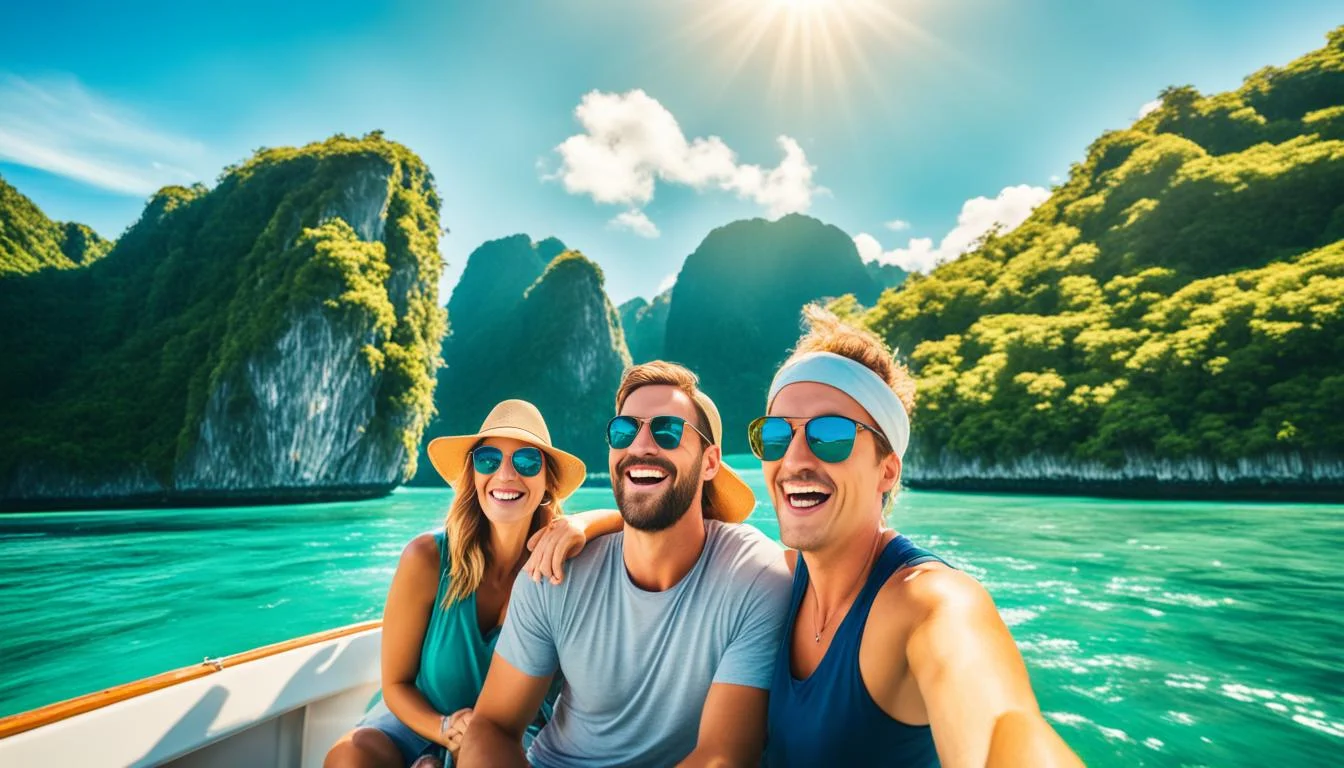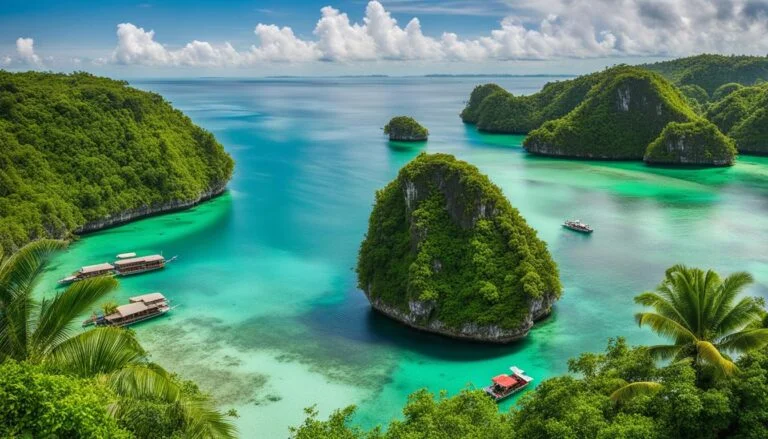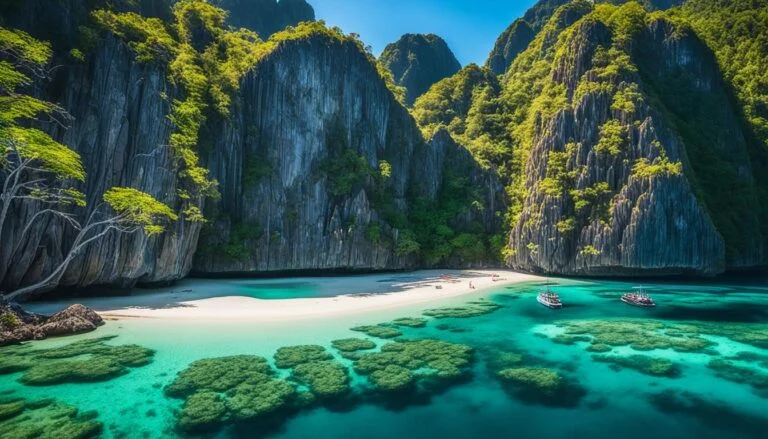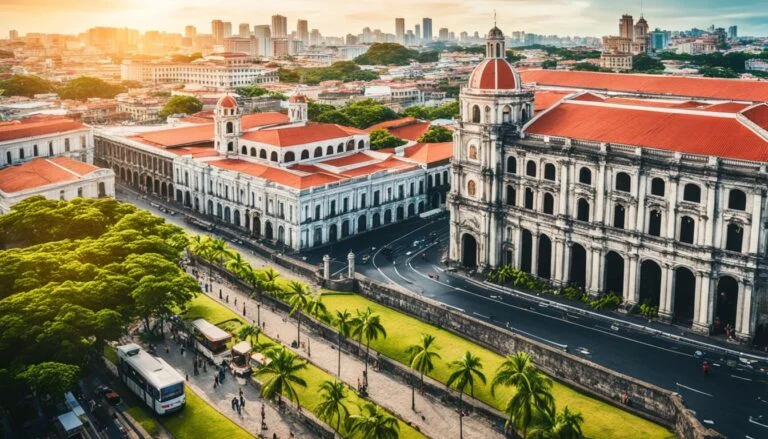The Ultimate Island Hopping Experience in the Philippines!
Have you ever dreamed of exploring a tropical paradise where pristine islands, turquoise waters, and vibrant marine life converge? The Philippines, an archipelago of over 7,000 stunning islands, is the ultimate destination for an unforgettable island hopping adventure1. Whether you’re craving a laidback beach getaway or an immersive cultural experience, this natural wonderland offers something for every type of traveler1.
Key Takeaways
- Discover the Philippines’ breathtaking islands, from neon-streaked cities to forest villages and firefly-lit nights.
- Explore a treasure trove of over 7,000 islands, each with its own unique charm and adventure.
- Immerse yourself in the vibrant local culture and savor the flavors of the Philippines.
- Unwind on pristine beaches, snorkel in crystal-clear waters, and encounter the region’s diverse marine life.
- Embark on a seamless and social island hopping experience tailored for young travelers.
Introduction to Philippines Island Hopping
The Philippines is renowned as an archipelago of natural wonders, from its jade-green rice terraces to its vibrant sunsets that set the sea ablaze2. With no mainland, island hopping is the quintessential way to experience the diverse beauty and culture of this tropical paradise3.em>
Travelers can hop between idyllic islands, encountering bustling cities with oceanside skyscrapers, vibrant street food scenes, and charming modes of transportation like jeepneys. The best island hopping experiences often involve time spent both on the coast and inland, immersing visitors in the Philippines’ rich history and traditions4.
From the emerald waters of Palawan to the white sand beaches of Boracay, the Philippines archipelago offers a diverse array of natural wonders and beach destinations3. Whether you’re seeking adventure, relaxation, or cultural immersion, island hopping in the Philippines is the ultimate way to uncover the country’s hidden gems2.
Planning Your Island Hopping Adventure

When planning a Philippines island hopping adventure, several key factors must be considered. Flights and ferries are the primary modes of transportation, with options to fly directly into destinations like El Nido or take longer ferry rides between islands5. The Philippines consists of over 7,000 islands and islets, offering a vast array of natural riches and diverse experiences to explore6. The Philippines actually has over 7,640 islands, surpassing the popularly known 7,107 islands.
Budgeting for accommodations, activities, and transportation is crucial, as costs can add up quickly5. Central Visayas itinerary spans 183 miles and takes approximately 16 days to complete, while5 Palawan itinerary covers a distance of 310 miles and requires around 14 days to finish7. Percentage of major tourist destinations visited in the Philippines during a 10-day island hopping adventure: 60% (6 out of 10).
Determining which islands to visit is perhaps the most important decision, as the Philippines offers a wealth of options to explore. Factors like desired activities, popular attractions, and travel time between destinations should all be weighed when curating the perfect island hopping itinerary7. Average duration of flights within the Philippines during island hopping itinerary: 1.5 hours, and7 average duration of boat trips between islands in the Philippines: 3.5 hours.
7 There are 4 organized tour options available in El Nido, Palawan (Option A, B, C, and D), and7 the estimated additional cost for a private boat tour in El Nido, Palawan compared to a group tour is about the same amount6. Boracay in Kalibo, Aklan is highlighted as one of the most popular destinations for island hopping in the Philippines, and6 Lakawon Island in Bacolod City boasts of having the largest floating bar in Asia5.
Itinerary 1: Central Visayas

The Central Visayas region of the Philippines is a captivating destination that blends rich culture, stunning natural landscapes, and incredible diving opportunities. This 16-day itinerary takes travelers on an unforgettable journey through the heart of the Philippine archipelago8.
The adventure begins on Mactan Island, where visitors can explore the guitar-making capital of Lapu-Lapu City and dive the vibrant reef wall. Next, the journey continues to Cebu Island, allowing travelers to delve into the country’s past by visiting sites like Magellan’s Cross and the Basilica del Santo Niño9.
From Cebu, the real island-hopping experience begins, with frequent ferries connecting Bohol, Panglao, and Negros Islands. The highlights of this leg include the iconic Chocolate Hills of Bohol, the charming university town of Dumaguete, and the renowned dive spot of Apo Island8.
Bohol and Panglao, located in the Central Visayas region, offer a range of attractions, including beaches, waterfalls, caves, sandbars, dive sites, chocolate hills, and resorts8. Balicasag Island, a popular dive site, is just a 20-minute boat ride from Alona Beach8. Bohol is home to over 1,200 chocolate hills, cone-shaped hills that turn brown during the dry season8.
As the journey continues, travelers can also explore Siquijor, an island in the southern Visayas that can only be accessed by ferry and is less touristy compared to other islands in the Philippines8. The island offers stunning attractions like Cambugahay Falls, Coral Cay, and Salagdoong Beach, providing a serene and immersive island experience8.
Philippines Island Hopping in Palawan
Palawan Island, often referred to as the “Last Frontier” of the Philippines, is a prime destination for island hopping enthusiasts10. Boasting around 1,780 islets scattered along its shores, Palawan offers a quintessential island hopping experience. The best place to start your adventure is the provincial capital of Puerto Princesa, which faces the smattering of islands in Honda Bay10.
Inland, travelers can explore the bamboo villages and the UNESCO-listed Puerto Princesa Subterranean River National Park, a natural wonder known for its underground river system10. At the northeastern tip of Palawan lies the limestone wonderland of El Nido, the gateway to the Bacuit Archipelago’s craggy islands and world-renowned wreck diving sites10.
The cost of an island hopping tour in Palawan can range from approximately PHP 1,500 to PHP 3,500 per person, depending on the package and group size10. Most Philippine island hopping tours in Palawan last for a full day, typically starting early in the morning and ending in the late afternoon, with some tours offering overnight stays on specific islands10.
Peak season for island hopping tours in Palawan is generally from December to May, when tours can get fully booked quickly due to the favorable weather10. The best time for island hopping tours in Palawan is during the dry season, from November to May, characterized by sunny and dry weather, ideal for exploring the various attractions10.
Travel agencies such as Guide to the Philippines offer customized island hopping tours in Palawan, allowing visitors to tailor their itineraries to their interests and preferences, enabling specific island visits or extended time at certain attractions10. While island hopping in Palawan is generally safe, it is crucial to ensure safety by following guidelines, using life vests on boats, avoiding damaging corals, and complying with instructions from tour guides10.
In El Nido, the popular Tour A offers a 6-hour island hopping experience including attractions like Big Lagoon, Secret Lagoon, Shimizu Island, and Seven Commandos Beach, with a shared boat option costing ₱ 1,260.00 and a private boat option priced at ₱ 2,460.0011. Tour B in El Nido includes Snake Island, Cudugnon and Cathedral Caves, Entaluala Island, and Popolkan Island, all to be explored during a 6-hour tour, with a shared boat costing ₱ 1,365.00 and a private boat option available at ₱ 2,630.0011.
The 7-hour El Nido Tour C features attractions like Matinloc Island, Secret Beach, Hidden Beach, Helicopter Island, and Tapiutan Island, with the brush with Helicopter Island providing snorkeling and water sports opportunities, and the secluded Hidden Beach offering stunning landscapes for photography11.
With a high level of engagement on the topic of Philippines Island Hopping in Palawan, as evident from the 2K views, 9 replies, and 7 participants12, the itinerary provided includes a detailed breakdown of travel plans within the Philippines, including flights and stays in different locations such as Boracay, Cebu, Bohol, and Palawan12. Recommendations were made by forum members to skip Boracay due to tourist presence and to consider exploring outside areas in Cebu and Puerto Princesa for a more authentic experience12.
Concerns were raised regarding the amount of time spent commuting versus touring, suggesting that travel within the Philippines can be time-consuming12. Reference to the difficulty in finding ethical ways to see whale sharks in Oslob, indicating challenges with ethical tourism practices in the Philippines12. Discussion of long-distance ferries with stops along the route, highlighting alternative transportation options within the Philippines12.
Suggestions were made to slow down the pace of travel to enjoy a more relaxed vacation experience, emphasizing the importance of enjoying the culture and hospitality of the Philippines12. Forum participants shared personal travel experiences, insights on different destinations such as Bohol and Palawan, and tips for a more diverse travel itinerary in the Philippines12.
Island Highlights and Activities

The Philippines’ 7,640 islands13 offer a wealth of activities for travelers to enjoy. Snorkeling and diving provide unparalleled opportunities to encounter vibrant marine life, from sea snakes and green turtles to angelfish, wrasse, and even larger creatures like barracudas, manta rays, and whale sharks14. Kayaking and boat tours are an ideal way to explore the archipelago’s coves, lagoons, and beaches, while hiking and trekking through the islands’ interiors reveal lush forests, bamboo villages, and stunning natural formations like the Chocolate Hills.
Siargao Island, for instance, caters to a diverse range of travelers, from surfers and foodies to thrill-seekers13. The TawHai Floating Bar in Lakawon Island is recognized as the largest floating bar in Asia13, while Samal Island in Davao is known as the largest resort city in the Philippines13. Panglao Island in Bohol boasts a marine sanctuary with more than 11 species of dolphins to observe13, and Moalboal Island in Cebu offers adventurous activities like trekking, climbing, rappelling, and canyoneering, as well as the opportunity to swim alongside sea turtles and witness the Moalboal sardine run13.
No matter the activity, the Philippines’ islands promise unforgettable experiences. From snorkeling and diving in vibrant coral reefs to hiking and kayaking through lush forests and serene coves, the archipelago offers a diverse range of activities that cater to every type of traveler141513.
Tips for Hassle-Free Island Hopping

Embarking on an island hopping adventure in the Philippines requires careful planning and consideration of various logistical aspects. Arranging transportation, whether by flight, ferry, or rental car, well in advance is crucial to ensure smooth transfers between islands16. Accommodations range from budget-friendly hostels to luxurious resorts, so researching options that align with your travel style and budget is essential16.
When curating your island hopping itinerary, it’s vital to factor in travel time between destinations and allow for flexibility, as delays and unexpected events are common occurrences16. Additionally, budgeting for activities, meals, and incidentals will help travelers avoid surprises and enjoy a hassle-free island hopping experience16.
Exploring the diverse islands of the Philippines can be an immensely rewarding experience, but it’s important to anticipate and plan for potential challenges17. By considering factors such as transportation, accommodations, and budgeting, you can ensure a smooth and enjoyable island hopping adventure17.
Furthermore, it’s advisable to carry sufficient local currency, as ATM availability may be limited in smaller islands18. Additionally, being prepared for potential weather delays, flight cancellations, and traffic congestion can help you navigate the unexpected with ease18.
Remember, island hopping in the Philippines is an opportunity to immerse yourself in the country’s stunning natural beauty and warm hospitality. By planning ahead and staying flexible, you can create an unforgettable island hopping experience1718.
Conclusion
The Philippines’ Philippines island hopping experience offers a captivating and diverse travel adventure like no other. With over 7,000 islands1920 to explore, this tropical paradise promises unforgettable memories for every type of traveler. From the vibrant cities and historic sites to the pristine beaches and lush forests, the Philippines’ natural wonders, rich culture, and warm hospitality create a travel experience that is truly one-of-a-kind.
By carefully planning an island hopping itinerary, visitors can immerse themselves in the stunning landscapes, vibrant marine life, and unique cultural offerings that the Philippines has to offer. Destinations like El Nido, Coron, and Siargao19 in the Central Visayas, as well as Mindanao’s Samal Island, Camiguin Island, and Tawi-Tawi21 provide a wealth of activities, from snorkeling and diving to kayaking and cultural exploration.
Whether seeking relaxation or adrenaline-fueled travel experiences, the Philippines island hopping adventure promises unforgettable moments in a truly tropical paradise. With the right preparation and safety precautions1920, travelers can immerse themselves in the Philippines’ natural beauty and create lasting memories that will inspire them to return again and again.







